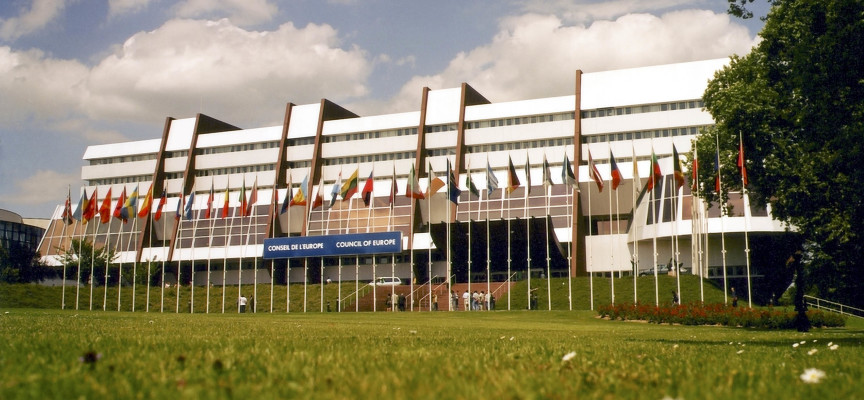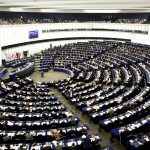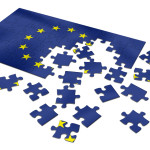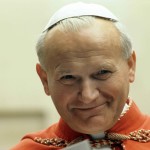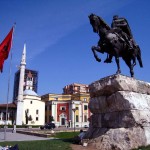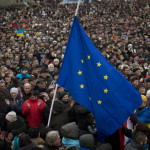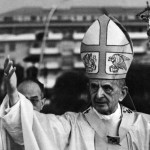On November 25th, Pope Francis will be in Strasbourg to address the two main European institutions. As Pope John Paul II did before him in 1988, he too will address the Parliamentary Assembly of the Council of Europe and the European Parliament. But so many things have changed in the 26 years since the Polish Pope’s epoch-marking visited those institutions, which were still ruled by Western Europe back then!
Figures speak for themselves: back then, there were 21 States in the Council of Europe, now there are 47. The EU Parliament has not just doubled up in size, its political role too is very different now from what it used to be. Nowadays, despite its many flaws, now it is really a representative of European people, with remarkably wide legal and political responsibilities.
We will be all the more curious, then, to find out which message Pope Francis, the Pope from the other side of the world but one who also has deep European roots, will send to these two European institutions.
There are not many historical precedents. Only a couple of times have Popes spoken to parliaments or parliamentary assemblies. The latest speech of that kind was held by Pope Benedict XVI during his visit to Berlin, at the German Bundestag, in 2011. It was a speech that impressed intellectuals and politicians in Germany.
Impatiently can we now look at Strasbourg and see whether Pope Francis has a vision for Europe, and what such vision is like. He has most powerfully influenced European politics when he visited Lampedusa, the island in Southern Italy, at the beginning of His papacy. His poignant appeal for Italy and Europe to have an open attitude to the African refugees contributed to remarkably increase the flows of refugees coming to Europe through the Mediterranean regions.
If now he addresses the Parliamentary Assembly of the Council of Europe and the European Parliament, he will probably mention that again but he will definitely touch upon other topics as well.
It is interesting to think about which images and which metaphors he is going to use. On several occasions, John Paul II spoke of the East and the West as of the “two lungs” with which Europe should breathe. Benedict XVI loved the image of the Christian roots of Europe. In his very different rhetoric, Pope Francis will certainly find new images to describe the reality and vision of the continent.
Am 25. November wird Papst Franziskus in Straßburg vor den beiden wichtigsten europäischen Institutionen sprechen. Wie schon zuvor Papst Johannes Paul II. Im Jahr 1988, so wird auch er vor der Parlamentarischen Versammlung des Europarates und vor dem Europäischen Parlament eine Rede halten. Aber wie viel hat sich geändert in den 26 Jahren seit jenem historischen Auftritt des polnischen Papstes vor den beiden damals noch westeuropäisch dominierten Institutionen!
Allein die Zahlen sprechen für sich: Zum Europarat gehörten damals 21 Staaten, heute sind es 47. Und das EU Parlament hat sich nicht nur zahlenmäßig mehr als verdoppelt, auch sein politischer Rang ist heute ein ganz anderer als damals. Es ist, trotz vielfältiger Mängel, eine echte europäische Volksvertretung mit beachtlichen Kompetenzen in der Gesetzgebung und in der politischen Gestaltung geworden.
Umso gespannter darf man sein, welche Botschaft Papst Franziskus, der Papst vom anderen Ende der Welt – der aber zugleich auch starke europäische Wurzeln hat – diesen beiden europäischen Gremien sagen wird.
Es gibt in der Historie nicht viele Präzedenzfälle. Nur wenige Male haben Päpste vor Parlamenten oder parlamentarischen Versammlungen gesprochen. Die letzte Rede dieser Kategorie hielt Papst Benedikt XVI. bei seinem Besuch in Berlin vor dem Deutschen Bundestag im Jahr 2011. Es war eine Rede, die Intellektuelle und Politiker in Deutschland beeindruckte.
Mit Spannung wird man nun in Straßburg beobachten können, ob Papst Franziskus eine Vision von Europa hat, und wie diese aussieht. Seinen bislang nachhaltigsten Einfluss auf die europäische Politik hat er ausgeübt, als er zu Beginn seines Pontifikats die süditalienische Insel Lampedusa besuchte. Sein damals vorgetragener dramatischer Appell für eine offene Haltung Italiens und Europas gegenüber den afrikanischen Flüchtlingen hat zu einer deutlichen Zunahme des Flüchtlingsstroms beigetragen, der über das Mittelmeer nach Europa kommt.
Wenn er nun vor der parlamentarischen Versammlung des Europarates sowie vor dem Europäischen Parlament redet, wird er vermutlich wiederum darüber, aber auch über ganz andere Themen sprechen.
Interessant ist die Frage, welche Bilder und Metaphern er benutzen wird. Johannes Paul II. sprach mehrere Male von Ost und West als den “beiden Lungenflügeln”, mit denen Europa atmen solle. Benedikt XVI. liebte das Bild von dem christlichen Wurzeln Europas. In seiner ganz anderen Rhetorik wird Papst Franziskus sicherlich neue Bilder finden, um die Realität und die Vision des Kontinents zu beschreiben.
Quale sarà il messaggio di papa Francesco?
Il 25 novembre papa Francesco a Strasburgo parlerà di fronte alle due principali istituzioni europee. Come già fece papa Giovanni Paolo II nel 1988, anche lui farà un discorso all’Assemblea parlamentare del Consiglio d’Europa e al Parlamento europeo. Ma quante cose sono cambiate nei 26 anni da quella visita storica del Papa polacco a quelle istituzioni ancora dominate in quel momento dall’Europa occidentale!
I numeri parlano da soli: al Consiglio d’Europa all’epoca appartenevano 21 Stati, oggi sono 47. Il Parlamento dell’UE non solo è numericamente più che raddoppiato, anche il suo ruolo politico oggi è molto diverso da quello che era allora. Oggi, nonostante i molti difetti, è diventato una vera rappresentanza popolare europea con una notevole competenza in materia legislativa e nella gestione politica.
Tanto più curiosi possiamo essere su quale sarà il messaggio che papa Francesco, il Papa venuto dall’altra parte del mondo, ma che ha anche forti radici europee, rivolgerà a questi due organismi europei.
Non ci sono nella storia molti precedenti. Solo un paio di volte i papi hanno parlato di fronte a parlamenti o assemblee parlamentari. L’ultimo discorso di questo tipo lo ha tenuto papa Benedetto XVI durante la sua visita a Berlino di fronte al Bundestag tedesco nel 2011. È stato un discorso che ha colpito gli intellettuali e politici in Germania.
Con impazienza ora si potrà guardare a Strasburgo e vedere se Papa Francesco ha una visione per l’Europa e quali ne sono i tratti. Egli ha esercitato la sua influenza sulla politica europea quando ha visitato Lampedusa, l’isola dell’Italia meridionale, all’inizio del suo pontificato. Il suo appello drammatico per un atteggiamento aperto dell’Italia e dell’Europa nei confronti dei rifugiati africani ha contribuito a un significativo aumento del flusso di profughi provenienti attraverso il Mediterraneo verso l’Europa.
Ora, di fronte all’Assemblea parlamentare del Consiglio d’Europa e al Parlamento europeo, probabilmente ne parlerà di nuovo, ma toccherà certo anche altri argomenti.
Interessante è la domanda su quali immagini e metafore userà. Giovanni Paolo II ha parlato più volte di Oriente e Occidente come i “due polmoni” con cui l’Europa dovrebbe respirare. Benedetto XVI ha amato l’immagine delle radici cristiane dell’Europa. Nella sua retorica molto diversa, Papa Francesco di sicuro troverà nuove immagini per descrivere la realtà e la visione del continente.
Quel sera le message du Pape François?
Le 25 novembre, le Pape François à Strasbourg parlera devant les deux principales institutions européennes. Comme le Pape Jean Paul II l’avait déjà fait en 1988, lui aussi fera un discours à l’Assemblée parlementaire du Conseil de l’Europe et au Parlement Européen. Mais combien de choses ont changé en 26 ans, depuis cette visite historique du pape polonais à ces institutions encore dominées alors par l’Europe occidentale !
Les chiffres parlent d’eux-mêmes : à l’époque, 21 États appartenaient au Conseil de l’Europe, aujourd’hui ils sont 47. Le Parlement de l’UE non seulement a plus que redoublé, mais son rôle politique aujourd’hui est très différent de ce qu’il était alors. Aujourd’hui, malgré ses nombreux défauts, il constitue une véritable représentation populaire européenne avec une compétence importante en matière de législation et dans la gestion politique.
Nous ne pouvons qu’être curieux du message que le Pape François, ce Pape du bout du monde avec de fortes racines européennes, apportera à ces deux organismes européens.
Il y a peu de précédents dans l’histoire. Deux fois seulement des papes ont parlé face à des parlements ou à des assemblées parlementaires. C’est le Pape Benoît XVI qui a tenu le dernier discours de ce type durant sa visite à Berlin face au Bundestag allemand en 2011. Son discours avait frappé les intellectuels et les politiques d’Allemagne.
C’est donc avec impatience que nous regarderons vers Strasbourg pour voir si le Pape François a une vision pour l’Europe et quels en sont les traits. Il a exercé son influence sur la politique européenne lors de sa visite à l’île de Lampedusa, dans le sud de l’Italie, au début de son pontificat. Son appel dramatique en faveur d’un comportement ouvert de l’Italie et de l’Europe envers les réfugiés africains a contribué à une augmentation significative du flux des réfugiés qui traversent la Méditerranée en direction de l’Europe.
Si aujourd’hui il s’adresse à l’Assemblée parlementaire du Conseil de l’Europe et au Parlement européen, il en parlera sans doute à nouveau, mais il touchera certainement d’autres sujets également.
Il est certes intéressant de se demander quelles images et métaphores il entend utiliser. Jean Paul II a parlé à plusieurs reprises d’Orient et d’Occident comme de “deux poumons” avec lesquels l’Europe devrait respirer. Benoît XVI a aimé l’image des racines chrétiennes de l’Europe. Avec sa rhétorique très différente de celle de ses prédécesseurs, le Pape François trouvera certainement de nouvelles images pour décrire la réalité et sa vision du continent.
Ludwig Ring-Eifel
Chefredakteur, Kna (Deutschland)
Latest posts by Ludwig Ring-Eifel (see all)
- What will be Pope Francis’ message? - 14 ottobre 2014
- Stop the slaughterers in Iraq - 16 agosto 2014
- The Strasbourg Burqa judgment - 10 luglio 2014

